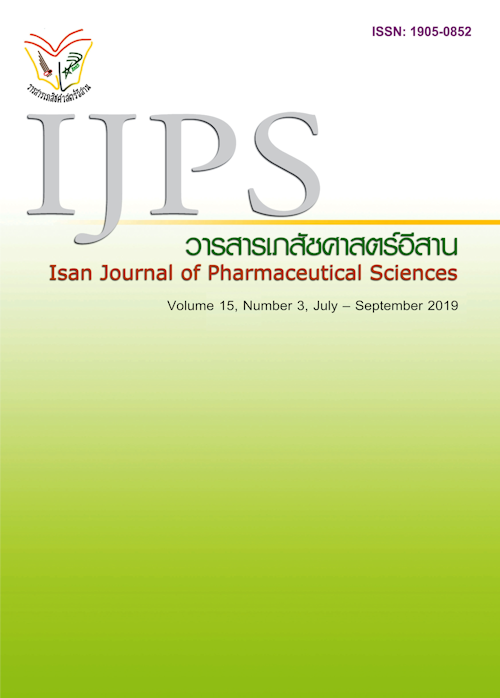Evaluation of Polypharmacy Appropriateness in Elderly Patients Using the STOPP/START Criteria 2014 at Supphasithipasong Hospital, Ubon Ratchathani Province
Main Article Content
Abstract
Elderly patients often have numerous comorbidities that associate to advanced age, polypharmacy and receiving Potentially Inappropriate Medications (PIMs). PIMs in the elderly is related with Adverse Drug Events (ADEs), serious drug-drug interaction and may contribute to excessive morbidity and mortality. The Screening Tool of Older Persons' potentially inappropriate Prescriptions/Screening Tool to Alert doctors to the Right Treatment criteria (STOPP/START) 2014 are the assessing tools for the appropriateness of medications in the elderly. The aims of this study were to identify percentage and frequency of PIMs in elderly using the STOPP/START criteria 2014 and to compare the percentage and frequency of PIMs between two elderly age groups (age 65-74 versus age 75 and over). Methods: The retrospective study was conducted by collecting data using the outpatient prescription database between 1st January and 31st March 2017. Results: A total 410 patients were included in the study. Among them, 212 (51.7%) were female. Mean age of the patients was 74.09±6.76 years (range 65-95 years). Patients had many comorbidities, for example, hypertension (57.1%), dyslipidemia (34.1%) and diabetes (29.0%). The average number of medicines prescribed per patient was 9.23±4.14. According to the criteria, 232 patients (56.6%) contained at least one PIM (STOPP criteria 55.6% (228/410), START criteria 15.1% (49/410). Our study shows that PIMs were found in group age 75 year and older (63%), which higher than the age group of 65-74 year (51.5%). There was statistically significant difference between the two patient groups. The three most common PIMs are as follows; 1) Benzodiazepines and its sedative effect that may cause decreased sensorium and impair balance) (19.7%); 2) Benzodiazepines used every day for more than 4 weeks with no indication for longer treatment (16.1%) and 3) receiving First-generation antihistamines (11.7%), respectively. Conclusion: The highest prevalence of PIMs was found for benzodiazepines and antihistamines drugs. Stakeholders should encourage to promote rational use of these medicines in terms of indication and duration of therapy with the aim to reduce PIMs from these medicines.
Article Details
In the case that some parts are used by others The author must Confirm that obtaining permission to use some of the original authors. And must attach evidence That the permission has been included
References
American Geriatrics Society 2015 Beers Criteria Update Expert Panel. American Geriatrics Society 2015 updated Beers criteria for potentially inappropriate medication use in older adults. J Am Geriatr Soc. 2015; 63: 2227–46.
Chen YC, Hwang SJ, Lai HY, et al. Potentially inappropriate medication for emergency department visits by elderly patients in Taiwan. Pharmacoepidemiol Drug Saf. 2009; 18(1): 53-61.
Dagli RJ, Sharma A. Polypharmacy: a global risk factor for elderly people. J Int Oral Health. 2014; 6(6):i-ii.
Doungthipsirikul S. Preliminary results of the Thai Elderly's Health Survey 2013 under the Health Promotion Program for the Elderly and the Disabled [Online]. 2013 [cited 2017 Nov 17]. Available from: https://www.hitap.net/wp-content/uploads/2014/12/PB_Elderly-Survey-2556-_Final.pdf.
Hussain A, Ali I, Khan AU, Khan TM. Glibenclamide-induced profound hypoglycaemic crisis: a case report. Ther Adv Endocrinol Metab. 2016; 7(2): 84-7.
Imamura T. Significant Efficacy of Tramadol/Acetaminophen in Elderly Patients with Chronic Low Back Pain Uncontrolled by NSAIDs: An Observational Study. Open orthop J. 2015; 9:120-5.
Limpawattana P, Kamolchai N, Theeranut A, Pimporm J. Potentially inappropriate prescribing of Thai older adults in an internal medicine outpatient clinic of a tertiary care hospital. Afr J Pharm Pharmacol. 2013; 34(7): 2417-22.
Lionakis N, Mendrinos D, Sanidas E, et al. Hypertension in the elderly. World J Cardiol. 2012; 4(5): 135-47.
Malekmakan L, Khajehdehi P, Pakfetrat M, et al. Prevalence of chronic kidney disease and its related risk factors in elderly of southern iran: a population-based study. ISRN Nephrol. 2013; 2013:1-6.
Ministry of Social Development and Human Security. thailand elderly [Online]. 2015 [cited 2017 Nov 17]. Available from: https://www.m-society.go.th/article_attach/13225/17347.pdf.
Montgomery P, Lilly J. Insomnia in the elderly. BMJ Clin Evid. 2007; 2302.
O’Mahony D, Gallagher P, Ryan C, et al. STOPP & START criteria: a new approach to detecting potentially inappropriate prescribing in old age. Eur Geriatr Med. 2010; 1: 45–51.
O'Mahony D, O'Sullivan D, Byrne, S et al. STOPP/START criteria for potentially inappropriate prescribing in older people: version 2. Age Ageing. 2015; 44(2): 213–18.
Ouchi Y, Rakugi H, Arai H, et al. Redefining the elderly as aged 75 years and older: Proposal from the Joint Committee of Japan Gerontological Society and the Japan Geriatrics Society. Geriatr Gerontol Int. 2017; 17(7):1045-7.
Ryan C, O'Mahony D, Kennedy J, et al. Potentially inappropriate prescribing in an Irish elderly population in primary care. Br J Clin pharmacol. 2009; 68(6): 936-47.
Sehgal V, Bajwa SJ, Sehgal R, et al. Polypharmacy and potentially inappropriate medication use as the precipitating factor in readmissions to the hospital. J Family Med Prim Care. 2013; 2(2):194-9.
Sub-committee to promote rational drug use. Rational Drug Use Hospital Manual. Bangkok: Publishing House of Agriculture Cooperative Federation of Thailand ; 2016.
Weinstein JR, Anderson S. The aging kidney: physiological changes. Adv Chronic Kidney Dis. 2010; 17(4): 302-7


